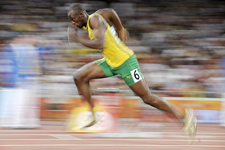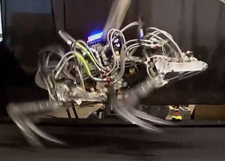DOD Robot Can Outrun Usain Bolt
Daily News Article — Posted on September 21, 2012

Usain Bolt, Olympic gold medalist
(from CBS Local DC) WASHINGTON – …A robot created by the Department of Defense can now run faster than Olympic gold medalist Usain Bolt.
The Cheetah robot – developed by the Defense Advanced Research Project Agency (DARPA) – broke its own land speed record of 18 mph on Sept 5 by going 28.3 mph in a 20-meter split.
Bolt, who set the world record in the 100 meters with a 9.58 run in 2009, reached a peak speed of 27.78 mph during a 20-meter split in the World Athletics Championship.
The video posted by DARPA on its website shows the Cheetah robot hitting the new “world-record” mark before losing its footing on the treadmill.

Cheetah robot (see video under “Resources” below)
The Cheetah robot, which is being developed and tested by Boston Dynamics, is looking to move from the treadmill to natural terrain next year, but for now Cheetah runs on a treadmill in a lab to allow researchers to monitor its progress, refine algorithms and maintain its moving parts.
“Our real goal is to create a robot that moves freely outdoors while it runs fast,” Dr. Alfred Rizzi, technical lead on the Cheetah project, told Wired magazine. “We are building an outdoor version that we call WildCat, that should be ready for testing early next year.”
DARPA states on its website that it hopes to use the Cheetah robot in emergency responses, humanitarian missions and other defense missions.
“What DARPA is doing with its robotics programs is attempting to understand and engineer into robots certain core capabilities that living organisms have [mastered]: efficient locomotion, manipulation of objects and adaptability to environments,” Gill Pratt, DARPA program manager, said in a press release. “Our Cheetah bot borrows ideas from nature’s design to inform stride patterns, flexing and unflexing of parts like the back, placement of limbs and stability. What we gain through Cheetah and related research efforts are technological building blocks that create possibilities for a whole range of robots suited to future Department of Defense missions.”
©2012 CBS News. All Rights Reserved. Reprinted here for educational purposes only. May not be reproduced on other websites without permission from CBS News. Visit the website at washington.cbslocal.com.
Background
DARPA:
The Defense Advanced Research Projects Agency (DARPA) was established in 1958 to prevent strategic surprise from negatively impacting U.S. national security and create strategic surprise for U.S. adversaries by maintaining the technological superiority of the U.S. military.
To fulfill its mission, the Agency relies on diverse performers to apply multi-disciplinary approaches to both advance knowledge through basic research and create innovative technologies that address current practical problems through applied research. DARPA’s scientific investigations span the gamut from laboratory efforts to the creation of full-scale technology demonstrations in the fields of biology, medicine, computer science, chemistry, physics, engineering, mathematics, material sciences, social sciences, neurosciences and more. As the DoD’s primary innovation engine, DARPA undertakes projects that are finite in duration but that create lasting revolutionary change. (from
darpa.mil)
BOSTON DYNAMICS:
Boston Dynamics is an engineering company that specializes in building dynamic robots and software for human simulation. The company began as a spin-off from the Massachusetts Institute of Technology, where National Academy of Engineering member Marc Raibert and his colleagues first developed robots that ran and maneuvered like animals. They founded the company in 1992, and their ground-breaking work continues to inspire several of the company's activities. (from
bostondynamics.com)
THE CHEETAH ROBOT:
The Cheetah is a four-footed robot that gallops at 18 mph, which is a land speed record for legged robots. The previous record was 13.1 mph, set in 1989 at MIT. Cheetah development is funded by DARPA's Maximum Mobility and Manipulation program. This robot has an articulated back that flexes back and forth on each step, thereby increasing its stride and running speed, much like the animal does. The current version of the Cheetah robot runs on a high-speed treadmill in the laboratory where it is powered by an off-board hydraulic pump and uses a boom-like device to keep it running in the center of the treadmill. Later this year we plan to start testing a free-running Cheetah that will operate more naturally in the field. (from
bostondynamics.com/robot_cheetah.html)


